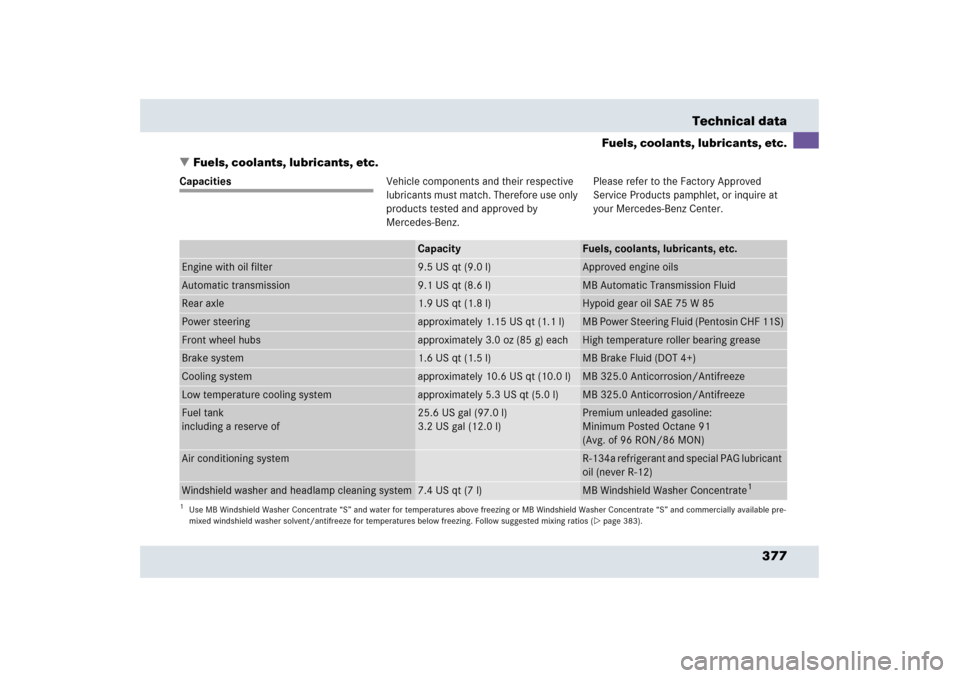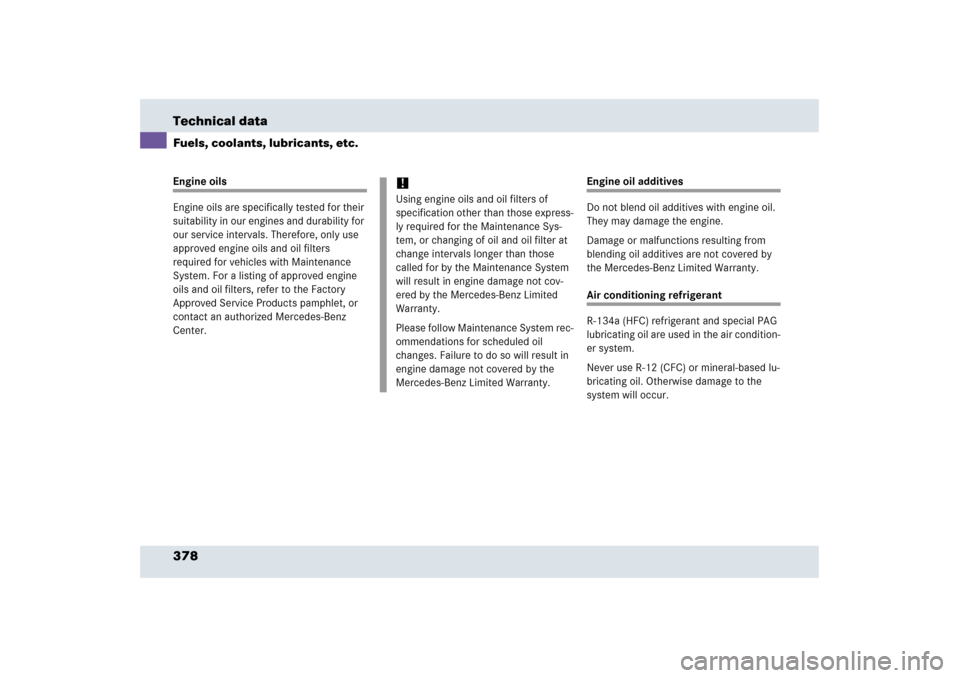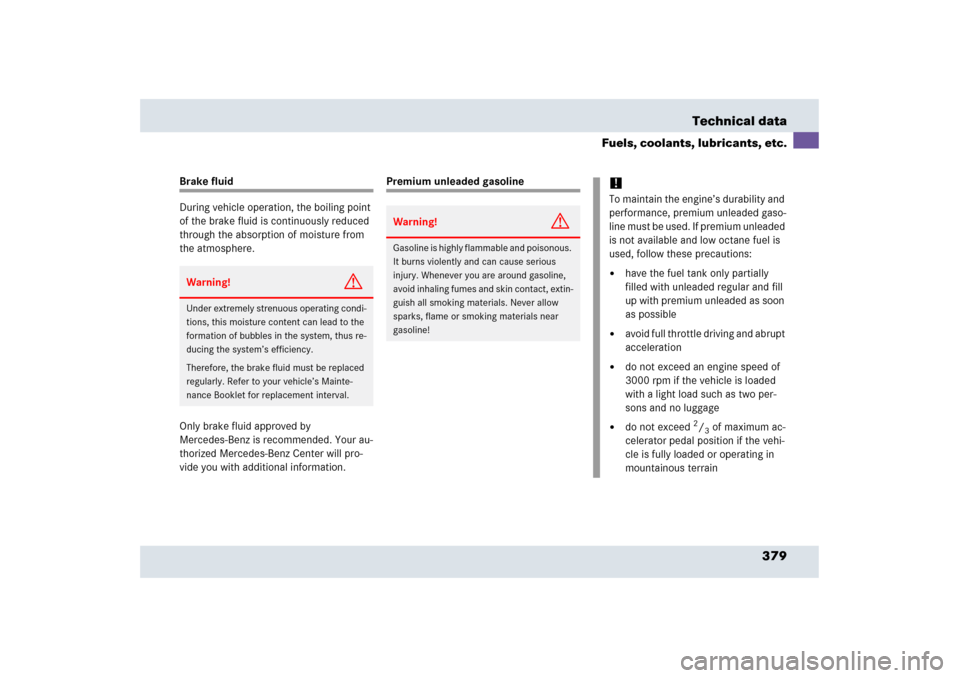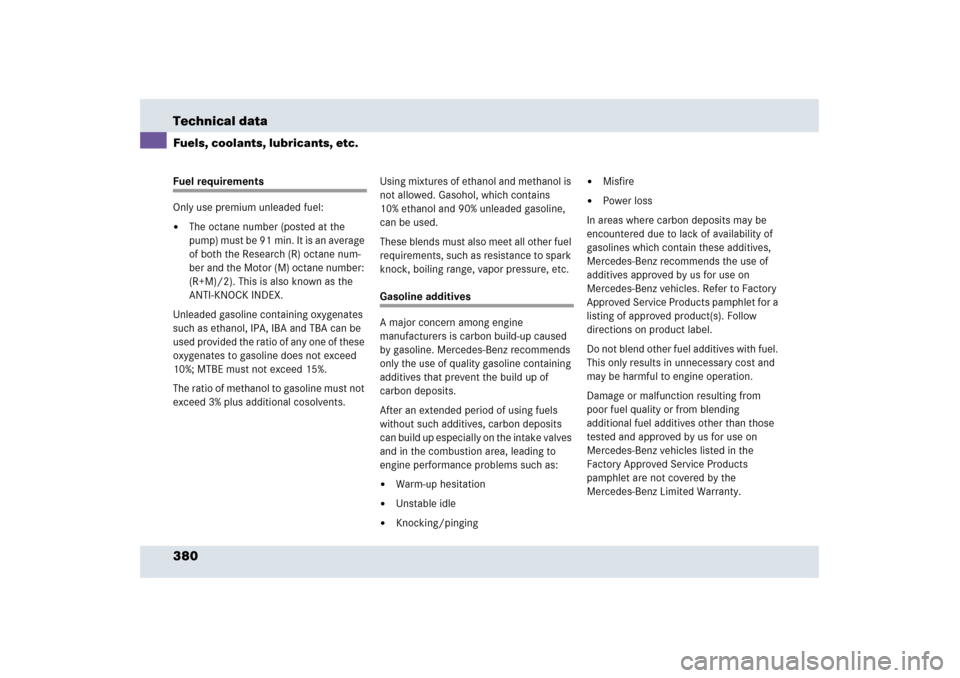Page 365 of 409
Technical dataSpare parts service
Warranty coverage
Identification labels
Layout of poly-V-belt drive
Engine
Rims and tires
Electrical system
Main dimensions
Weights
Fuels, coolants, lubricants, etc.
Page 369 of 409
368 Technical dataIdentification labels1Vehicle certification label with Vehicle
Identification Number
2Product option code plate with paint
number
The vehicle certification plate with the Ve-
hicle Identification Number and the vehicle
identification plate (certification plate)
with the paint number are located on the
A-pillar on the driver’s side.
The Vehicle Identification Number is locat-
ed on the driver’s side in the bottom corner
of the windshield.3Vehicle Identification Number
4Vacuum line routing diagram label
5Emission control information label,
includes both federal and California
certification exhaust emission
standards
Engine number
The engine number is engraved on the un-
derside of the engine and can only be read
after removing the casing on the bottom of
the engine.
There is also a plate on the left-hand side
of the engine cover.
iWhen ordering parts, please specify
vehicle identification and engine num-
bers.
Page 371 of 409
370 Technical dataEngineModel
SLR (199.376)
1
1The quoted data apply only to the standard vehicle. See an authorized Mercedes-Benz Center for the corre-
sponding data of all special bodies and special equipment.Engine
155
Mode of operation
4-stroke engine, gasoline injection
No. of cylinders
8
Bore
3.82 in (97.00 mm)
Stroke
3.60 in (92.00 mm)
Total piston displacement
331.8 cu in (5439 cm
3)
Compression ratio
8.8:1
Output acc. to SAE J 1349
617 hp/6500 rpm
2
(460 kW/6500 rpm)
2Premium fuel required. Performance may vary with fuel octane rating.Maximum torque acc. to SAE J 1349
575 lb-ft/3250-5000 rpm
(780 Nm/3250-5000 rpm)
Maximum engine speed
7000 rpm
Firing order
1-5-4-2-6-3-7-8
Poly-V-belt
2425 mm/1244 mm
Page 378 of 409

377 Technical data
Fuels, coolants, lubricants, etc.
�Fuels, coolants, lubricants, etc.
CapacitiesVehicle components and their respective
lubricants must match. Therefore use only
products tested and approved by
Mercedes-Benz. Please refer to the Factory Approved
Service Products pamphlet, or inquire at
your Mercedes-Benz Center.
Capacity
Fuels, coolants, lubricants, etc.
Engine with oil filter
9.5 US qt (9.0 l)
Approved engine oils
Automatic transmission
9.1 US qt (8.6 l)
MB Automatic Transmission Fluid
Rear axle
1.9 US qt (1.8 l)
Hypoid gear oil SAE 75 W 85
Power steering
approximately 1.15 US qt (1.1 l)
MB Power Steering Fluid (Pentosin CHF 11S)
Front wheel hubs
approximately 3.0 oz (85 g) each
High temperature roller bearing grease
Brake system
1.6 US qt (1.5 l)
MB Brake Fluid (DOT 4+)
Cooling system
approximately 10.6 US qt (10.0 l)
MB 325.0 Anticorrosion/Antifreeze
Low temperature cooling system
approximately 5.3 US qt (5.0 l)
MB 325.0 Anticorrosion/Antifreeze
Fuel tank
including a reserve of
25.6 US gal (97.0 l)
3.2 US gal (12.0 l)
Premium unleaded gasoline:
Minimum Posted Octane 91
(Avg. of 96 RON/86 MON)
Air conditioning system
R-134a refrigerant and special PAG lubricant
oil (never R-12)
Windshield washer and headlamp cleaning system
7.4 US qt (7 l)
MB Windshield Washer Concentrate
1
1Use MB Windshield Washer Concentrate “S” and water for temperatures above freezing or MB Windshield Washer Concentrate “S” and commercially available pre-
mixed windshield washer solvent/antifreeze for temperatures below freezing. Follow suggested mixing ratios (�page 383).
Page 379 of 409

378 Technical dataFuels, coolants, lubricants, etc.Engine oils
Engine oils are specifically tested for their
suitability in our engines and durability for
our service intervals. Therefore, only use
approved engine oils and oil filters
required for vehicles with Maintenance
System. For a listing of approved engine
oils and oil filters, refer to the Factory
Approved Service Products pamphlet, or
contact an authorized Mercedes-Benz
Center.
Engine oil additives
Do not blend oil additives with engine oil.
They may damage the engine.
Damage or malfunctions resulting from
blending oil additives are not covered by
the Mercedes-Benz Limited Warranty.Air conditioning refrigerant
R-134a (HFC) refrigerant and special PAG
lubricating oil are used in the air condition-
er system.
Never use R-12 (CFC) or mineral-based lu-
bricating oil. Otherwise damage to the
system will occur.
!Using engine oils and oil filters of
specification other than those express-
ly required for the Maintenance Sys-
tem, or changing of oil and oil filter at
change intervals longer than those
called for by the Maintenance System
will result in engine damage not cov-
ered by the Mercedes-Benz Limited
Warranty.
Please follow Maintenance System rec-
ommendations for scheduled oil
changes. Failure to do so will result in
engine damage not covered by the
Mercedes-Benz Limited Warranty.
Page 380 of 409

379 Technical data
Fuels, coolants, lubricants, etc.
Brake fluid
During vehicle operation, the boiling point
of the brake fluid is continuously reduced
through the absorption of moisture from
the atmosphere.
Only brake fluid approved by
Mercedes-Benz is recommended. Your au-
thorized Mercedes-Benz Center will pro-
vide you with additional information.
Premium unleaded gasoline
Warning!
G
Under extremely strenuous operating condi-
tions, this moisture content can lead to the
formation of bubbles in the system, thus re-
ducing the system’s efficiency.
Therefore, the brake fluid must be replaced
regularly. Refer to your vehicle’s Mainte-
nance Booklet for replacement interval.
Warning!
G
Gasoline is highly flammable and poisonous.
It burns violently and can cause serious
injury. Whenever you are around gasoline,
avoid inhaling fumes and skin contact, extin-
guish all smoking materials. Never allow
sparks, flame or smoking materials near
gasoline!
!To maintain the engine’s durability and
performance, premium unleaded gaso-
line must be used. If premium unleaded
is not available and low octane fuel is
used, follow these precautions:�
have the fuel tank only partially
filled with unleaded regular and fill
up with premium unleaded as soon
as possible
�
avoid full throttle driving and abrupt
acceleration
�
do not exceed an engine speed of
3000 rpm if the vehicle is loaded
with a light load such as two per-
sons and no luggage
�
do not exceed
2/3 of maximum ac-
celerator pedal position if the vehi-
cle is fully loaded or operating in
mountainous terrain
Page 381 of 409

380 Technical dataFuels, coolants, lubricants, etc.Fuel requirements
Only use premium unleaded fuel:�
The octane number (posted at the
pu m p) m us t b e 91 mi n. It is an a vera ge
of both the Research (R) octane num-
ber and the Motor (M) octane number:
(R+M)/2). This is also known as the
ANTI-KNOCK INDEX.
Unleaded gasoline containing oxygenates
such as ethanol, IPA, IBA and TBA can be
used provided the ratio of any one of these
oxygenates to gasoline does not exceed
10%; MTBE must not exceed 15%.
The ratio of methanol to gasoline must not
exceed 3% plus additional cosolvents.Using mixtures of ethanol and methanol is
not allowed. Gasohol, which contains
10% ethanol and 90% unleaded gasoline,
can be used.
These blends must also meet all other fuel
requirements, such as resistance to spark
knock, boiling range, vapor pressure, etc.
Gasoline additives
A major concern among engine
manufacturers is carbon build-up caused
by gasoline. Mercedes-Benz recommends
only the use of quality gasoline containing
additives that prevent the build up of
carbon deposits.
After an extended period of using fuels
without such additives, carbon deposits
can build up especially on the intake valves
and in the combustion area, leading to
engine performance problems such as:�
Warm-up hesitation
�
Unstable idle
�
Knocking/pinging
�
Misfire
�
Power loss
In areas where carbon deposits may be
encountered due to lack of availability of
gasolines which contain these additives,
Mercedes-Benz recommends the use of
additives approved by us for use on
Mercedes-Benz vehicles. Refer to Factory
Approved Service Products pamphlet for a
listing of approved product(s). Follow
directions on product label.
Do not blend other fuel additives with fuel.
This only results in unnecessary cost and
may be harmful to engine operation.
Damage or malfunction resulting from
poor fuel quality or from blending
additional fuel additives other than those
tested and approved by us for use on
Mercedes-Benz vehicles listed in the
Factory Approved Service Products
pamphlet are not covered by the
Mercedes-Benz Limited Warranty.
Page 382 of 409

381 Technical data
Fuels, coolants, lubricants, etc.
Coolants
The engine coolant is a mixture of water
and anticorrosion/antifreeze, which pro-
vides:�
corrosion protection
�
freeze protection
�
boiling protection (by increasing the
boiling point)
The cooling system was filled at the factory
with a coolant providing freeze protection
to approximately -22°F (-30°C) and corro-
sion protection.
If the antifreeze mixture is effective to
-22°F (-30°C), the boiling point of the cool-
ant in the pressurized cooling system is
reached at approximately 266°F (130°C).
The coolant solution must be used year
round to provide the necessary corrosion
protection and increase in the boil-over
protection. Refer to Maintenance Booklet
for replacement interval.Coolant system design and coolant used
determine the replacement interval. The
replacement interval published in the
Maintenance Booklet is only applicable if
MB 325.0 anticorrosion/antifreeze solu-
tion or other Mercedes-Benz approved
products of equal specification (see
Factory Approved Service Products pam-
phlet) are used to renew the coolant con-
centration or bring it back up to the proper
level.
To provide important corrosion protection,
the solution must be at least 45% anticor-
rosion/antifreeze (equivalent to freeze
protection to approximately
- 22°F [-30°C]). If you use a solution that is
more than 55% anticorrosion/antifreeze
(freeze protection to approximately
- 49°F [-45°C]), the engine temperature
will increase due to the lower heat transfer
capability of the solution. Therefore, do not
use more than this amount of anticorro-
sion/antifreeze.If the coolant level is low, water and
MB 325.0 anticorrosion/antifreeze should
be used to bring it up to the proper level
(have cooling system checked for signs of
leakage). Please make sure the mixture is
in accordance with label instructions.
The water in the cooling system must meet
minimum requirements, which are usually
satisfied by normal drinking water. If you
are not sure about the water quality, con-
sult an authorized Mercedes-Benz Center.